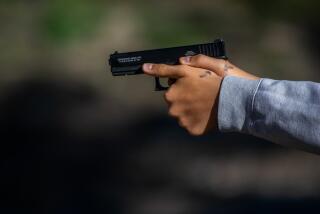Hospital Staff Gets Lesson on Gang Violence
Both new and veteran hospital staff members got a graphic introduction to the trauma of gang warfare Tuesday, viewing photos of patients who had been wounded and hearing from emergency room doctors.
Doctors and staff at County-USC Medical Center deal with an average of seven gunshot victims a day, many of them the result of gang violence. Audience members listened intently with audible gasps and later expressed shock at the presentation.
Dr. Juan Asensio, the hospital’s chief of trauma surgery, told them violence knows no social distinctions. “A bullet doesn’t differentiate between race, social status or religious beliefs,” he said.
The aim of the presentation, “Gangs and Spiritualty,” which included two ex-gang members and two chaplains, was to create awareness of the complexities of gang violence and how to be prepared for it.
Rayna Sarna, a gang intervention specialist with the nonprofit educational group SEA, stressed the importance of knowing about different gangs in the area.
“Sometimes you can have different gang members side by side [in the hospital], and a lot of the doctors and nurses don’t know,” Sarna said. “That can lead to fights and, who knows, maybe somebody pulls out a gun and starts firing.”
In addition to educating staff members, the presentation brought together anti-gang experts and members of the Eastside community.
Asensio said that through Tuesday’s conference and a slide presentation of gunshot victims, he tries to strip away the glamour of gang life often shown through movies and rap stars.
“We try to deglamorize violence, to put a face to violence, to show that in one moment that you raise your hand in anger, it can affect generations,” Asensio said.
The level of gun violence and the cruel facts about gang life made a Spanish doctor, a fellow at the County-USC trauma center, cringe.
“We don’t see a lot of gunshot wounds like that,” said Soledad Monton.
Esteban Gambaro, an Argentine surgeon, praised the panelists.
He said: “It’s the only way to educate people.”
More to Read
Sign up for Essential California
The most important California stories and recommendations in your inbox every morning.
You may occasionally receive promotional content from the Los Angeles Times.










